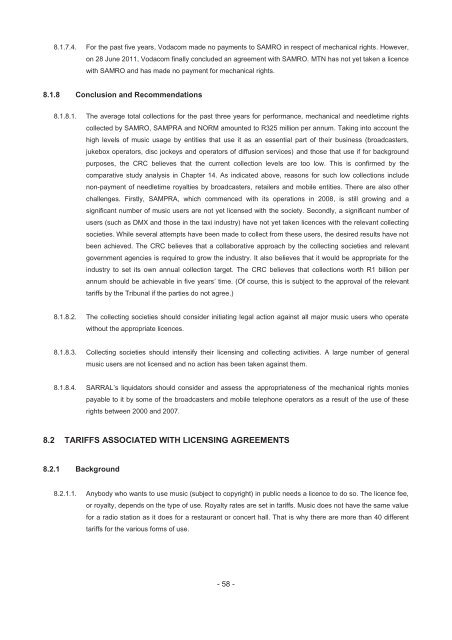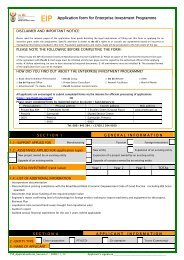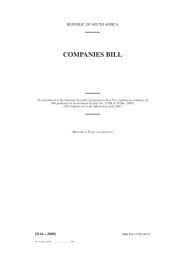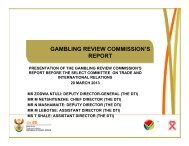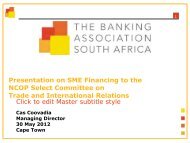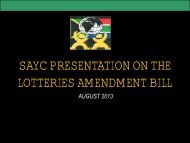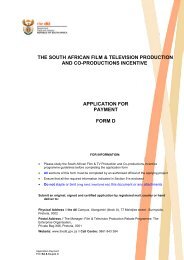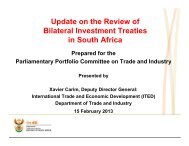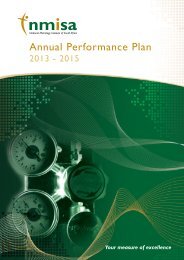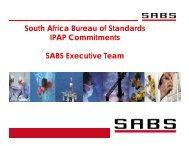Copyright Review Commission Report - ICT Law and Regulation ...
Copyright Review Commission Report - ICT Law and Regulation ...
Copyright Review Commission Report - ICT Law and Regulation ...
- No tags were found...
Create successful ePaper yourself
Turn your PDF publications into a flip-book with our unique Google optimized e-Paper software.
8.1.7.4. For the past five years, Vodacom made no payments to SAMRO in respect of mechanical rights. However,on 28 June 2011, Vodacom finally concluded an agreement with SAMRO. MTN has not yet taken a licencewith SAMRO <strong>and</strong> has made no payment for mechanical rights.8.1.8 Conclusion <strong>and</strong> Recommendations8.1.8.1. The average total collections for the past three years for performance, mechanical <strong>and</strong> needletime rightscollected by SAMRO, SAMPRA <strong>and</strong> NORM amounted to R325 million per annum. Taking into account thehigh levels of music usage by entities that use it as an essential part of their business (broadcasters,jukebox operators, disc jockeys <strong>and</strong> operators of diffusion services) <strong>and</strong> those that use if for backgroundpurposes, the CRC believes that the current collection levels are too low. This is confirmed by thecomparative study analysis in Chapter 14. As indicated above, reasons for such low collections includenon-payment of needletime royalties by broadcasters, retailers <strong>and</strong> mobile entities. There are also otherchallenges. Firstly, SAMPRA, which commenced with its operations in 2008, is still growing <strong>and</strong> asignificant number of music users are not yet licensed with the society. Secondly, a significant number ofusers (such as DMX <strong>and</strong> those in the taxi industry) have not yet taken licences with the relevant collectingsocieties. While several attempts have been made to collect from these users, the desired results have notbeen achieved. The CRC believes that a collaborative approach by the collecting societies <strong>and</strong> relevantgovernment agencies is required to grow the industry. It also believes that it would be appropriate for theindustry to set its own annual collection target. The CRC believes that collections worth R1 billion perannum should be achievable in five years’ time. (Of course, this is subject to the approval of the relevanttariffs by the Tribunal if the parties do not agree.)8.1.8.2. The collecting societies should consider initiating legal action against all major music users who operatewithout the appropriate licences.8.1.8.3. Collecting societies should intensify their licensing <strong>and</strong> collecting activities. A large number of generalmusic users are not licensed <strong>and</strong> no action has been taken against them.8.1.8.4. SARRAL’s liquidators should consider <strong>and</strong> assess the appropriateness of the mechanical rights moniespayable to it by some of the broadcasters <strong>and</strong> mobile telephone operators as a result of the use of theserights between 2000 <strong>and</strong> 2007.8.2 TARIFFS ASSOCIATED WITH LICENSING AGREEMENTS8.2.1 Background8.2.1.1. Anybody who wants to use music (subject to copyright) in public needs a licence to do so. The licence fee,or royalty, depends on the type of use. Royalty rates are set in tariffs. Music does not have the same valuefor a radio station as it does for a restaurant or concert hall. That is why there are more than 40 differenttariffs for the various forms of use.- 58 -


